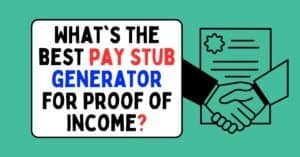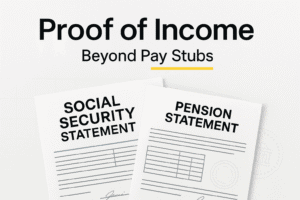How to Create Legal Pay Stubs When You’re Self-Employed

By FinancialDocsProvider.com Editorial Team
Last updated: August 2025
If you freelance, run a side business, or own a small firm, you’ve probably been asked for a self-employed pay stub when applying for an apartment, vehicle, or loan. Unlike W-2 employees, your income arrives via invoices, platforms, or dividends—so “pay stub” often means a clear, readable summary derived from your real records and paired with official forms. This guide explains what “legal” means in the US, UK, and Canada, what documents underwriters actually want, and how to assemble a compliant packet without changing facts.
Our role is simple: we edit, format, and organize your existing financial documents to improve clarity. We do not fabricate numbers, dates, or parties—ever. You keep ownership of your records; we help present them cleanly so lenders and landlords can verify them quickly. If you need help with proof of income editing or bank statement formatting, our specialists follow compliance-first standards for the US, UK, and Canada.
Related Entities & Terms
- IRS (United States), Forms 1099-NEC/1099-K, Schedule C, Form 1040
- CFPB (US Consumer Financial Protection Bureau) & FTC (US Federal Trade Commission)
- HMRC (UK), SA302 calculation & Tax Year Overviews, P60/P45, payslips
- FCA (UK Financial Conduct Authority) and GOV.UK guidance
- CRA (Canada Revenue Agency), T1 General, T4/T2125 (Statement of Business or Professional Activities)
- FCAC (Financial Consumer Agency of Canada)
- NOA (Notice of Assessment) – Canada
- Underwriting, income verification, affordability assessment
- Invoices, statements of earnings, remittance summaries
- Gross vs. net pay, deductions, employer/contractor details
- PDF exports, OCR text layers, redaction & annotation
- Fraud, misrepresentation, identity verification
Below, you’ll learn the essential rules, the difference between lawful formatting and illegal alterations, and how to package documents so reviewers can approve them faster across the US, UK, and Canada.
Legal Basics: Formatting vs. Falsification (US, UK, Canada)
Across jurisdictions, the core idea is consistent: you can improve legibility and organize your records, but you may not change the facts. “Facts” include amounts, dates, names, tax IDs, account numbers, and payment sources. Think of a self-employed pay stub as a presentation layer created from records you already have (invoices, payouts, ledgers, and tax filings).
United States (US)
Underwriters often accept a self-employed pay stub that summarizes recent earnings, provided it reconciles to official documents such as Form 1099-NEC/1099-K, Schedule C, and bank statements. The CFPB and the FTC emphasize truthful representations and fair verification. For tax specifics, consult the IRS Small Business & Self-Employed pages.
United Kingdom (UK)
Lenders typically look for HMRC-issued materials. A self-employed “stub” is valid only when it reflects figures that match your SA302 and Tax Year Overview, plus recent bank credits. Guidance is set by regulators such as the FCA and HM Government via GOV.UK. You may also be asked for accountant letters that reconcile to HMRC numbers.
Canada (CA)
In Canada, acceptance hinges on alignment with CRA filings (T1 General, T2125) and your Notice of Assessment (NOA). Presentation aids are fine; altering figures is not. For consumer protection and verification context, see the FCAC and CRA.
Bottom line: a compliant “stub” packages existing evidence into a clear, standardized format—never inventing data.
What Edits Are Allowed (and Helpful)
The goal is clarity. If your records are accurate but messy, lawful editing makes them easier to verify. These edits focus on formatting, readability, and organization, not on changing the underlying facts.
Redaction & Privacy
- Mask full account numbers except the last 4 digits.
- Blur unrelated transactions on bank statements while leaving relevant deposits visible.
- Hide client names when NDAs require it; use “Client A” with a private mapping note if requested by underwriting.
Layout & Readability
- Standardize dates (e.g., YYYY-MM-DD) and currency labels (USD/GBP/CAD).
- Add a summary panel: gross, deductions, net, YTD, pay period.
- Ensure a selectable text layer (OCR) so underwriters can copy totals.
- Export to a non-editable PDF with embedded fonts.
Reconciliation Notes
- Include a one-page reconciliation that ties stub totals to invoices and bank deposits by date.
- List platform payouts (e.g., Stripe, PayPal, gig apps) with IDs so reviewers can spot-check.
Mini-Scenario
You’re a graphic designer paid by Stripe and direct invoices. Your quarterly income is stable, but deposits are labeled inconsistently. A lawful stub consolidates payouts into pay periods (e.g., semi-monthly), adds a YTD line, and lists the deposit IDs that correspond to your bank statement. Nothing is invented; everything reconciles.
What Counts as Illegal Alterations
The moment you change factual content—like increasing net pay, adding a deposit that never happened, or editing dates to create a fake pay cycle—you’ve crossed into falsification. That can trigger application denial, account closure, and potential civil or criminal consequences.
Potential Consequences
- Loan or lease denial and internal blacklisting with the lender/landlord group.
- Allegations of fraud or misrepresentation in credit applications.
- Tax exposure if falsified numbers conflict with IRS/HMRC/CRA filings.
- Permanent reputational harm with partners and platforms.
Our policy is categorical: we will not alter facts. We’ll format, label, and reconcile your real numbers so they stand up to verification.
Use Cases & Country-Specific Document Packets
Renters & Property Managers
Landlords want stable income and easy verification. Provide a recent self-employed pay stub that matches your deposits, plus 3–6 months of bank statements and your latest tax filing. If you operate multiple lines of business, label each revenue stream and note seasonality so the reviewer knows what to expect.
Auto Loans & Leasing
Auto lenders often request the most recent pay documentation and a YTD view. A well-formatted stub with a reconciliation page helps them trace totals to your bank. Include insurance quotes and any outstanding loan obligations; transparency speeds approvals.
Small-Business Loans (SBA, UK Start Up Loans, CA programs)
For SBA-type lending, show consistent revenue and tax compliance. Pair your stub with invoices, aging reports, and tax returns. In the UK, pair with SA302 and Tax Year Overview; in Canada, use T1/T2125 and NOA. Provide a short cover note explaining the business model and payment cadence.
Suggested Packets by Market
- US: Self-employed pay stub + 3–6 months bank statements + 1099-NEC/1099-K + Schedule C + copy of driver’s license.
- UK: Self-employed payslip-style summary + SA302 + Tax Year Overview + last 3–6 months bank statements.
- Canada: Stub-style earnings summary + T1 General + T2125 + latest NOA + 3–6 months bank statements.
What a Self-Employed Pay Stub Needs to Be Legal
- Clear employer/contractor info: your legal name, business name, address, and tax ID where applicable.
- Pay period dates and payment date that match actual deposits.
- Gross, deductions, and net; currency and frequency (weekly/biweekly/monthly).
- YTD totals and a short reconciliation note.
- Reference IDs: invoice numbers, payout IDs, or statement page references.
Include a footer saying “Prepared from existing records; no figures altered.” Reviewers appreciate the signal.
How We Work (Intake → Reconciliation → Formatting → Delivery)
1) Intake
You share recent invoices, payout reports, and bank statements via a secure folder. Tell us your typical pay frequency and whether you need US, UK, or Canada formatting conventions.
2) Reconciliation
We map each pay period’s totals to the underlying documents, then prepare a one-page cross-reference. We flag mismatches for you to correct (for example, a missing invoice or a payout split across multiple days).
3) Formatting & Quality Checks
- Add a readable stub layout with gross, deductions, net, and YTD.
- Embed fonts and ensure a selectable text layer (OCR).
- Apply privacy redactions while preserving verifiability.
- Insert country-specific notes (IRS/HMRC/CRA references).
4) Delivery
We deliver a non-editable PDF package with a stub, reconciliation, and a short cover note. If a reviewer requests a minor layout tweak (not a figure change), we provide a revised export. For scope and about our process, see our services page and pricing; or contact our team.
Boundaries We Won’t Cross
- No invented clients, deposits, or pay periods.
- No tax ID creation or impersonation.
- No bank-statement edits that change transaction facts.
- No “template” population with fictional data.
Fast Compliance Checklist
Before you submit your self-employed income packet, run through this list:
- Do stub totals tie to invoices and bank deposits for the pay period?
- Are YTD figures reconcilable to your accounting system?
- Are dates, currency, and frequency clearly labeled?
- Is personally identifiable information redacted appropriately?
- Is there a one-page reconciliation with reference IDs?
- Does the packet include your latest tax filing (US: 1099 + Schedule C; UK: SA302; CA: T1/T2125 + NOA)?
- Is your PDF non-editable, with embedded fonts and a text layer?
- Have you included a short cover note to explain seasonality?
Packaging Tips
- US: Align pay periods to actual deposit clusters (e.g., 1st–15th, 16th–end-month).
- UK: Use HMRC terminology (SA302, Tax Year Overview). Include accountant letter if requested.
- Canada: Include NOA page showing assessed income; label CAD amounts.
Need help assembling this swiftly? Explore our proof of income editing options or check our pricing.
Common Red Flags That Trigger Rejections
- Mismatched dates: Deposit date doesn’t match the pay period on the stub.
- Round-number syndrome: Totals always end in “00” without cents; looks artificial.
- Font inconsistencies: Multiple typefaces suggesting pasted elements.
- Unverifiable payer: Client or platform name absent or misspelled.
- Unsupported deductions: Tax/benefit deductions with no basis for a self-employed filer.
- Currency confusion: USD/GBP/CAD mixed without clear labels.
- Missing reconciliation: No traceability back to invoices and bank deposits.
Mini-Scenario
A rideshare driver submits a stub showing weekly net pay, but bank statements show uneven daily payouts from the platform. Without a reconciliation paragraph and payout IDs, the reviewer can’t tie numbers together and flags the file. Adding a one-page cross-reference resolves it.
Helpful Resources
Authoritative guidance for each market:
- IRS: Small Business & Self-Employed (US)
- CFPB: Consumer Protection (US)
- GOV.UK: Government Services & HMRC Links (UK)
- FCA: UK Financial Conduct Authority (UK)
- CRA: Canada Revenue Agency (CA)
- FCAC: Financial Consumer Agency of Canada (CA)
Helpful pages on our site:
- Need polished documents? See our financial document services.
- Curious about costs? Visit pricing.
- Questions about scope? Read about our process.
- Ready to start? contact our team.
FAQs
Is a self-employed pay stub legally valid?
Yes—if it accurately summarizes real income and reconciles to official records (invoices, bank deposits, and tax filings). It’s a presentation tool, not a substitute for IRS/HMRC/CRA documents.
What documents should I include with my stub?
Typically 3–6 months of bank statements plus tax documents (US: 1099 + Schedule C; UK: SA302 + Tax Year Overview; Canada: T1/T2125 + NOA). Include a one-page reconciliation with reference IDs.
Can I redact client names or account numbers?
Yes. Redaction for privacy is a lawful formatting edit. Keep the last 4 digits of account numbers and provide a private mapping if underwriters request it.
Will you change figures if a lender wants a higher income?
No. We never change factual amounts, dates, or parties. We’ll help present the truth clearly—nothing more.
How fast can you deliver?
Turnaround depends on file volume and clarity. Most packets are formatted after intake and reconciliation. For scope, see our services and pricing, or contact our team.
Need accurate, reliable financial documents fast? Contact FinancialDocsProvider.com now.








Add comment